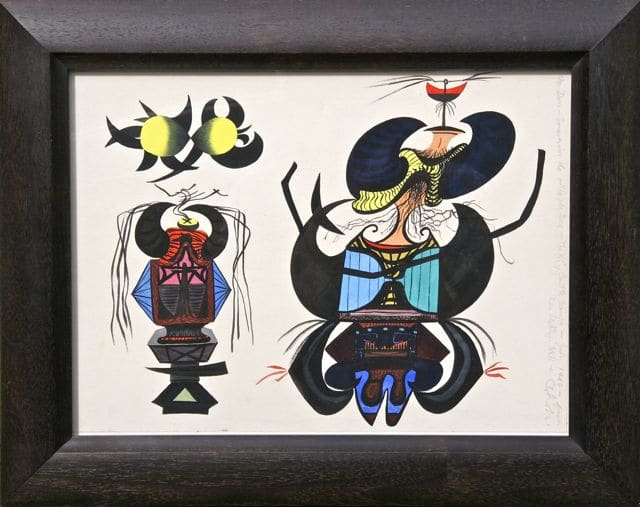Charles H. Howard
 Souvenir by Charles H. Howard, 1948, Gouache, 10×14
Souvenir by Charles H. Howard, 1948, Gouache, 10×14
Charles Howard was born into a family of creatives. His father, John Galen Howard, was a rising architect with a powerful presence in the lives of Charles and his two other brothers, John and Robert. And although she did not pursue a career in the field, Charles’s mother, Mary Robertson Bradbury Howard, had studied art prior to settling down with her growing family. All three sons went on to make a permanent mark in the art world that is still discussed to this day.
In 1902, Charles’s father was hired to both design the campus of University of California Berkeley and take on a position teaching architecture, and at the young age of 3, Charles settled there. Despite the prominence of the arts in their home life, Charles and John, unlike their brother, Robert, did not initially study the arts until after school. Charles majored in journalism and went on to graduate school at Harvard and Columbia universities. His urge to embark on an artistic career began with a chance encounter on a two year long trip to Europe – a trip he initially went on for writing purposes. It was in a rural town on the outskirts of Venice, Italy that the young Charles came across a work by Giorgione which he describes as an almost religious awakening. As a result he promptly relocated to Paris to further learn about painting and found that he could better express and convey the full depths of emotion through the visual arts rather than words.
Upon his return to U.S soil in 1925, the newborn artist settled in Greenwich Village, New York. He fully immersed himself in the chaos that was downtown and dedicated himself to his craft, getting by painting murals and furbishing Louis Bouché and Rudolph Guertler galleries. Although Howard never sought formal training, his hard work proved to have paid off when he was initiated into the surrealist group alongside the celebrated surrealist, Julien Levy. In light of his association with the renowned artist, it facilitated his acceptance as one of New York’s elites in the art world.
In the early 1930’s, Charles pursued his next chapter in London with his British born wife, Madge Knight, also a well known surrealist artist. There, he became involved with another artistic group known as Unite One, a group dedicated to surrealism and abstraction stretching across all forms of visual art. He made his mark in the UK when he participated in the International Surrealist Exhibition in 1936 in the New Burlington Galleries and three years later had a solo show launched by Peggy Guggenheim at Guggenheim Jeune in London.
In the wake of WW11, the two relocated to San Francisco in 1940 where they returned to a more working class lifestyle as Charles worked long hours in a shipyard and took advantage of his journalism degree working as an editor in San Francisco’s War Information office. He was able to still fuel his artistic pursuits though through acquiring a teaching position at California School of Fine Arts. Charles continued to show his work in renowned galleries and museums including the Museum of Modern Art, The Whitney, and The Guggenheim in New York City, and subsequently earned a place in San Francisco’s California Palace of the Legion of Honor.
Howard and Knight eventually moved back to England in 1946 and found home in Helions Bumpstead where he continued his teaching at Camberwell School of Arts and Crafts. The two stayed there until 1970, when they relocated to Italy where they lived out the rest of their days.


 And many more
And many more